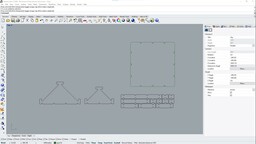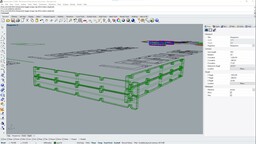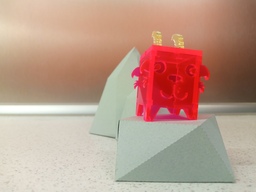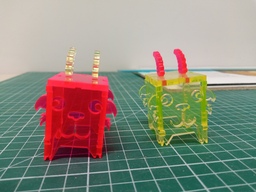4. Computer Controlled Cutting¶
Group Assignment¶
Characterize your lasercutter’s focus, power, speed, rate, kerf, joint clearance and types
Assignment¶
Cut something on the vinyl-cutter
Design, lasercut, and document a parametric construction kit, accounting for the lasercutter kerf, which can be assembled in multiple ways, and for extra credit include elements that aren’t flat
Prior knowledge¶
Well, this should have been one of the best weeks of my path in Fabacademy. First because of all computer aided prototyping machines, those for laser cutting and vinyl cutting are my favorites. Secondly because, in the University where I work, I have the possibility to use (assisted or autonomously) professional laser plotters (a Trotec Speedy 300 and a Seilaser NRGL) and a simple but reliable vinyl cutter (Roland CAMM-1 GX-24 24” ).
Also at Opendot Fablab, if I hadn’t been able to use the plotters at my disposal at work, I could have used the same plotter for vinyl and, for lasercut, a GCC SpiritGLS
But, sadly, as the famous Murphy’s Law states, this week I wasn’t able to exit from the office before the 7 p.m. and, after one day spent in Opendot learning how to set SpiritGLS and doing some exercises about parameters for engraving and cut, kerfs and defocusing on different materials, I ended working and doing the assignement with the machines that I’ve near my desk: two small plotter to cut paper, cardboard, felt and other soft materials (Silhouette Cameo 4 and Cricut Maker) and a “hobbyst” laser cutter Makeblock LaserBox with the worst software control in the world
Laser Cutting¶
After spending the following Thursday following the lesson doing tests after tests with the Opendot laser plotter … I had to start over with the Laserbox! I revised the template on the basis of the editable parameters of the machine (and decided to mark all the settings and notations in Italian so that they can also be useful for work colleagues) and, once I recovered as many materials as possible, I started to to cut.





Here I came up against the harsh reality of hobby machines: precision is an unattainable goal. You have to get the most “acceptable” result going well. And often two identical tests…give different results! By the end of the test I decided to realise my finaal object using basswood 3mm. thick ‘cause I had already a lot of sheets pre-cutted (the Laserbox Bedplate it’s just 300x500mm.)
After all these tries I was ready to start with the assignment. Quite ready. I don’t feel very confortable using Fusion 360. I keep on finding the sketch part very…frustrating…maybe I’m not into its way to work (yet…hope by the end of Fabacademy to find a resolution to our troubled romance) and, moreover, it keeps on crashing and it’s very slow. To acquire confidence I started doing some easy geometrical shapes and put some parametric constraints



Then proceed to cut it! (Part of the amusement it’s make funny noises while looking at the laser working…like “Ptiu! Ptiu! Laserrrrr!”)




It was satisfying and the assignment was “flagged”…but…c’mon! When I’ll be able once again to justify the use of this machine, doing what I want and just saying “It’s a job!”. So I proceed in designing and cutting a building kit (renamed “The Lincoln Laser Log”). This time I used Rhino to model it ‘cause I want to try Grasshopper for making parametric constraints. It was a big fail, very hard to get used to it, I will try again in the next week (Antonio, my instructor, use it, maybe he could help me) Here the result.









The beautiful box that you see in these images wasn’t made by me but by one of the students that work with us. She designed it and proceed to cut in order to store in it the blades that we use with Silhouette Cameo and Cricut Maker. I just re-adapted some measure and did the inside box with Canson paper (I’ll tell this story later…)




Vinyl Cutting¶
The vinyl cutter is similar to the laser cutter, but instead of a laser source there’s a sharp blade (actually different sharp blades, according to the material that we are going to cut). The one that I’m using the most is the Silhouette Cameo 4, with a work area of 30x60cm. We got a lot of blades but the one that I’m using the most is the autoblade that can cut a lot of materials. An interesting feature of this machine is its original software. It’s very complete and you can use it also to draw complex shapes. Obiouvsly I prefer to use other kind of programs to work with it, like Illustrator or Autocad. You can import .DXF files or .JPG, EPS or .PNG but you cannot use .SVG. To be honest this is one of the machine that I use the most, I like it and you can use it in some creative ways. For example you can use it with some programs of 3d modeling, setting a very low number of meshes, then smashing the model and finally exporting everything as .DXF. In the Silhouette Cameo software you can decide which line will be full cut and which one will be half-cut, then reassemble the model and obtain a 3d object (as shown in the following images)





Instead that using the 3d modeler software to smash the object, I’ve found better to use an easy and fast program that do specifically that kind of work. It’s named Pepakura Designer
For the assignment we need to re-trace/draw/import an image in a 2d vector software and make it a sticker. I decided to make a logo for my “LaserLincolnLog” construction kit, not so serious. I took inspiration for the design from The Noun Project site, and after having re-draw all the paths, I scaled the design ‘cause I wanted to put it on one of the pieces of wood (the flat big one).






Well, in the end I had some problems with the smallest letter and the punctuation. I’ll try to remember it in the next future.
Bonus of the week¶
Since the Fabacademy started I have a bit of difficulty in breaking away on the weekend, the only free time besides work, to take a ride in the mountains or go climbing. But above all I had to stop my search for the Dahu in the valleys around here, a research that has been going on for over 20 years! So, a bit for abstinence, a bit for fun, since I had made mountains of paper … why not make a small Dahu in plexiglass? I got the inspiration for the model from a photo that went around on the internet, an article that talked about joints and tolerances, I think. Then I redesigned the file with the measurements I wanted, the kerf of my laser cutter and the appearance more similar to that of the original Dahu. You can find the .DXF files here

